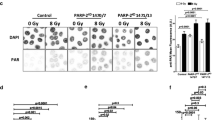Abstract
Several reports indicate that intracellular levels of NAD are rapidly decreased by DNA-damaging agents such as strep-tozotocin1–7, neocarzinostatin8,9 and ionising radiation8–11. Similarly, evidence obtained from studies in isolated nuclei and permeabilised cells indicates that DNA damage caused by several alkylating chemicals12–15, X rays16,17 and DNA-hydrolysing enzymes18,19 elicit a considerable increase in the activity of poly(ADP-ribose) polymerase, a chromosomal enzyme which uses NAD as a substrate in the formation of poly(ADP-ribose) in histones and other nuclear proteins20,21. Thus, it has been suggested that DNA-damaging agents lower NAD levels by causing an increase in poly(ADP-ribose) synthesis9,12,13. As DNA damage initiates DNA repair mechanisms, it has also been argued that poly(ADP-ribose) is involved in DNA repair8,12,14,17,22,23. Such possibilities would be strongly supported if an actual increase in the intracellular levels of poly(ADP-ribose) could be shown to occur after induction of DNA damage. We now present data obtained using a new technique which has enabled us to measure the levels of poly(ADP-ribose) in vivo in SV40 virus-transformed 3T3 cells (SVT2). We show that treatment of these cells with the powerful mutagen N-methyl-N′-nitro-N-nitrosoguanidine (MNNG) produces, concomitantly with a decrease in NAD levels, a dramatic increase in the intracellular levels of poly (ADP-ribose).
Similar content being viewed by others
References
Schein, P. S. & Loftus, S. Cancer Res. 28, 1501–1506 (1968).
Ho, C. K. & Hashim, S. A. Diabetes 21, 789–793 (1972).
Chang, A. Y. Biochim. biophys. Acta 261, 77–84 (1972).
Hinz, M., Katsilambros, N., Maier, V., Schatz, H. & Pfeiffer, E. F. FEBS Lett. 30, 225–228 (1973).
Schein, P. S., Cooney, D. A., McMenamin, M. G. & Anderson, T. Biochem. Pharmac. 22, 2625–2631 (1973).
Gunnarson, R., Berne, C. & Hellerstrom, C. Biochem. J. 140, 487–494 (1974).
Davies, M. I., Halldorsson, H., Shall, S. & Skidmore, C. J. Biochem. Soc. Trans. 4, 635–637 (1976).
Davies, M. I., Shall, S. & Skidmore, C. J. Biochem. Soc. Trans. 5, 949–950 (1977).
Goodwin, P. M., Lewis, P. J., Davies, M. I., Skidmore, C. J. & Shall, S. Biochim. biophys.Acta 543, 576–582 (1978).
Campagnari, F., Whitfield, J. F. & Bertazzoni, U. Expl Cell Res. 42, 646–656 (1966).
Hilz, H., Hlavica, P. & Bertram, B. Biochem. Z. 338, 283–299 (1963).
Smulson, M. E., Schein, P., Mullins, D. W. & Sudhakar, S. Cancer Res. 37, 3006–3012 (1977).
Sudhakar, S., Tew, K. D. & Smulson, M. E. Cancer Res. 39, 1405–1410 (1979).
Berger, N. A., Sikorski, G. W., Petzold, S. J. & Kurohara, K. K. Fedn Proc. 38, 619 (1979).
Jacobson, M. K. & Jacobson, E. L. J. supramolec. Struct. Suppl. 2, 74 (1978).
Benjamin, R. C. & Gill, D. M. J.supramolec. Struct. Suppl. 2, 74 (1978).
Benjamin, R. C. & Gill, D. M. Fedn Proc. 38, 619 (1979).
Miller, E. G. Biochem. biophys. Res. Commun. 66, 280–286 (1975).
Miller, E. G. Biochem. biophys. Acta 395, 191–200 (1975).
Hilz, H. & Stone, P. Rev. Physiol. Biochem. Pharmac. 76, 1–58 (1976).
Hayaishi, O. & Ueda, K. A. Rev. Biochem. 46, 95–116 (1977).
Davies, M. I., Halldorsson, H., Nduka, N., Shall, S. & Skidmore, C. J. Biochem. Soc. Trans. 6, 1056–1057 (1978).
Jacobson, E. L. & Narasimhan, G. Fedn Proc. 38, 619 (1979).
Barrio, J. R., Secrist, J. A. III & Leonard, N. J. Biochem. biophys. Res. Commun. 46, 597–604 (1972).
Magee, P. N., Montesano, R. & Preussman, R. in Chemical Carcinogens (ed. Searle, E. E.) (Am. chem. Soc. Monogr., Washington, 1976).
Lijinsky, W. Prog. Nucleic Acid Res. 17, 247–269 (1976).
Jacobson, E. L. & Jacobson, M. K. Archs Biochem. Biophys. 175, 627–634 (1976).
Cuatrecasas, P. J. biol. Chem. 245, 3059–3065 (1975).
Jacobson, E. L., Lange, R. A. & Jacobson, M. K. J. cell. Physiol. 99, 417–426 (1979).
Author information
Authors and Affiliations
Rights and permissions
About this article
Cite this article
Juarez-Salinas, H., Sims, J. & Jacobson, M. Poly(ADP-ribose) levels in carcinogen-treated cells. Nature 282, 740–741 (1979). https://doi.org/10.1038/282740a0
Received:
Accepted:
Issue Date:
DOI: https://doi.org/10.1038/282740a0
- Springer Nature Limited
This article is cited by
-
Ionizing radiation responses appear incidental to desiccation responses in the bdelloid rotifer Adineta vaga
BMC Biology (2024)
-
Poly(ADP-ribose) polymerase inhibition: past, present and future
Nature Reviews Drug Discovery (2020)
-
Targeting DNA repair and replication stress in the treatment of ovarian cancer
International Journal of Clinical Oncology (2017)
-
PARP Inhibitors in Prostate Cancer
Current Treatment Options in Oncology (2017)
-
Single cell resolution in vivo imaging of DNA damage following PARP inhibition
Scientific Reports (2015)





